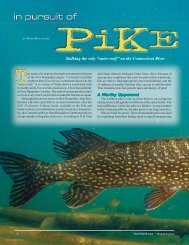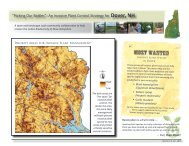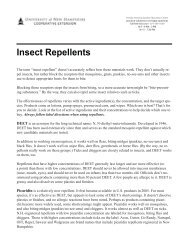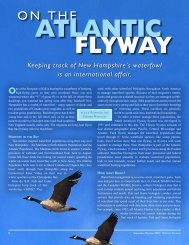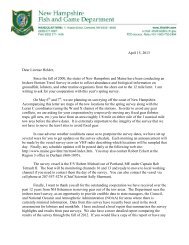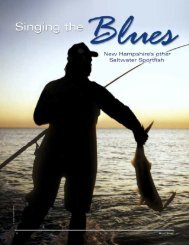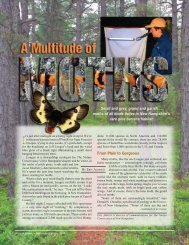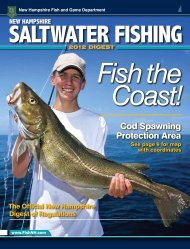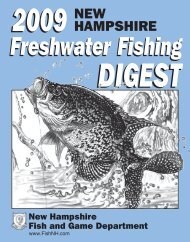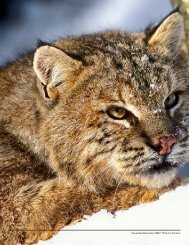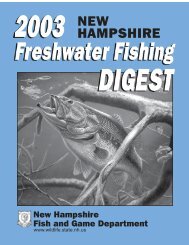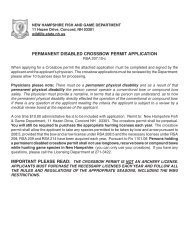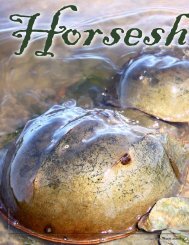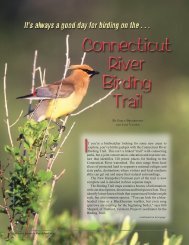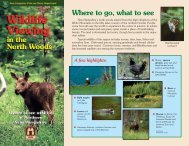Wildlife Management Areas - New Hampshire Fish and Game ...
Wildlife Management Areas - New Hampshire Fish and Game ...
Wildlife Management Areas - New Hampshire Fish and Game ...
You also want an ePaper? Increase the reach of your titles
YUMPU automatically turns print PDFs into web optimized ePapers that Google loves.
WILDLIFE MANAGEMENT AREAS<br />
A WONDERFUL WILDLIFE RESOURCE<br />
BY LIZA POINIER<br />
A<br />
S YOU’RE OUT SCOUTING hunting spots this fall—<br />
<strong>and</strong> dreaming about next spring’s fishing—take<br />
advantage of one of <strong>New</strong> <strong>Hampshire</strong>’s bestkept<br />
secrets: <strong>Wildlife</strong> <strong>Management</strong> <strong>Areas</strong>. Known as<br />
WMAs, these thous<strong>and</strong>s of acres of undeveloped<br />
public l<strong>and</strong> are owned by the N.H. <strong>Fish</strong> <strong>and</strong> <strong>Game</strong><br />
Department <strong>and</strong> designated as areas for wildlife resource<br />
conservation, hunting <strong>and</strong> fishing. To encourage<br />
you to get out <strong>and</strong> explore, <strong>Fish</strong> <strong>and</strong> <strong>Game</strong> has recently<br />
published on its website descriptions of 25 of the<br />
larger WMAs.<br />
How did these beautiful areas with flourishing<br />
wildlife come to be protected? Some hundred years<br />
ago, when wildlife had become scarce across the<br />
country <strong>and</strong> the concept of wildlife conservation was<br />
new, wildlife enthusiasts wondered what could be<br />
done to make wildlife populations grow. Few understood<br />
how complex a task the problem was; <strong>and</strong> none<br />
had a proven way of improving prospects for game<br />
animals <strong>and</strong> fish.<br />
In <strong>New</strong> <strong>Hampshire</strong>, the <strong>Fish</strong> <strong>and</strong> <strong>Game</strong> Commission<br />
(forebears of today’s <strong>Fish</strong> <strong>and</strong> <strong>Game</strong> Department)<br />
began hearing news of experiments in other states <strong>and</strong><br />
in Canada, showing that wildlife, while difficult to<br />
breed in captivity, flourished in the wild when given a<br />
chance. It sounds like common sense today, but at the<br />
time it was a radical notion. The Commission embraced<br />
the idea that they could help wildlife “by<br />
simply giving the game a chance, under favorable<br />
conditions, <strong>and</strong> under protection, to propagate<br />
themselves.”<br />
<strong>New</strong> <strong>Hampshire</strong> passed a law in 1917 allowing for<br />
the creation of wildlife sanctuaries. The <strong>Fish</strong> <strong>and</strong><br />
<strong>Game</strong> Commission started actively promoting the<br />
refuge concept in the 1920s, <strong>and</strong> taking advantage of<br />
l<strong>and</strong> gifts to create wildlife refuges <strong>and</strong> sanctuaries.<br />
Many of these early refuges were ultimately turned<br />
into <strong>Wildlife</strong> <strong>Management</strong> <strong>Areas</strong>. Today, the value of<br />
these l<strong>and</strong>s — both habitat value <strong>and</strong> economic value<br />
— is sky-high. Chuck Miner, l<strong>and</strong>owner <strong>and</strong> constituent<br />
relations administrator for <strong>Fish</strong> <strong>and</strong> <strong>Game</strong>, admires<br />
the foresight of those long-ago Commissioners <strong>and</strong><br />
others who worked to create these special places.<br />
“They were thinking about this 50, 60, 70 years ago,<br />
before the development boom,” he says. “We’re fortunate<br />
to have these places protected, not just for this<br />
generation, but to provide a wildlife legacy for the<br />
future.”<br />
The primary goal for WMAs is to protect <strong>and</strong><br />
maintain critical wildlife habitat. Many WMAs contain<br />
important wetl<strong>and</strong>s, or areas where threatened or<br />
endangered nongame species may be found. The larger<br />
areas are especially significant because they provide<br />
for a wide diversity of habitat.<br />
Hunting <strong>and</strong> fishing are allowed on WMA l<strong>and</strong>s, as<br />
is trapping by permit. Of course, all regular rules, laws<br />
<strong>and</strong> seasons apply for these activities.<br />
More than a hundred WMAs <strong>and</strong> conservation<br />
easements now dot the <strong>New</strong> <strong>Hampshire</strong> l<strong>and</strong>scape:<br />
from tiny parcels designed to protect specific, special<br />
habitats, to huge tracts like Enfield WMA, which<br />
covers more than 3,000 acres in Enfield <strong>and</strong> Grantham.<br />
Enfield is profiled here, along with Jones Brook <strong>and</strong><br />
Kearsarge, large WMAs popular with outdoor enthusiasts.<br />
But this is just a sampling; find out more on <strong>Fish</strong><br />
<strong>and</strong> <strong>Game</strong>’s website: www.wildlife.state.nh.us.<br />
continued on next page<br />
PHOTO OF ENFIELD WMA © JIM BLOCK<br />
WILDLIFE JOURNAL • November/December 2004 15
ENFIELD WMA<br />
3,062 Acres<br />
JONES BROOK WMA<br />
<strong>Fish</strong> <strong>and</strong> <strong>Game</strong> began acquiring l<strong>and</strong> in Enfield<br />
<strong>and</strong> Grantham for Enfield <strong>Wildlife</strong> <strong>Management</strong><br />
Area in 1968, adding other parcels to it over the<br />
years. Some 225 acres are held in a conservation<br />
easement, with the remaining acreage owned<br />
outright.<br />
Enfield WMA is mostly forested with northern<br />
hardwoods <strong>and</strong> scattered st<strong>and</strong>s of spruce <strong>and</strong> fir.<br />
It has marshl<strong>and</strong>s, beaver ponds <strong>and</strong> numerous<br />
waterbodies, including 17-acre Cole Pond,<br />
0 0.25 0.5 0.75 1<br />
10<br />
ENFIELD<br />
GRANTHAM<br />
ONE MILE<br />
89<br />
Smith Pond<br />
Halfmile<br />
Pond<br />
Mascoma Lake<br />
ENFIELD WMA<br />
HEAD LAKE RD.<br />
SHAKER HILL RD.<br />
In 1983, N.H. <strong>Fish</strong> <strong>and</strong> <strong>Game</strong> acquired the first<br />
863 acres of what would become Jones Brook<br />
WMA. In 1990-1992, the L<strong>and</strong> Conservation<br />
Investment Program purchased three adjoining<br />
parcels <strong>and</strong> assigned management responsibilities<br />
to <strong>Fish</strong> <strong>and</strong> <strong>Game</strong>. Now one of <strong>Fish</strong> <strong>and</strong><br />
<strong>Game</strong>’s largest <strong>and</strong> most diverse wildlife management<br />
areas, Jones Brook WMA covers parts of<br />
Brookfield, Middleton <strong>and</strong> <strong>New</strong> Durham.<br />
Jones Brook WMA is comprised of upl<strong>and</strong><br />
forest, with mixed st<strong>and</strong>s <strong>and</strong> various age classes<br />
of hardwoods, hemlock <strong>and</strong> white pine. It hosts an<br />
abundance of wildlife, including moose, whitetailed<br />
deer, bear, coyote, otter, beaver, turkeys,<br />
snowshoe hare, chipmunks, squirrels, hawks,<br />
ruffed grouse <strong>and</strong> American woodcock, in addition<br />
to many different songbirds <strong>and</strong> waterfowl<br />
species. It has important deer wintering areas,<br />
several ponds <strong>and</strong> streams, <strong>and</strong> a network of<br />
wetl<strong>and</strong>s.<br />
The topography is hilly <strong>and</strong> steep in places.<br />
4A<br />
HACKETT RD.<br />
GOODHUE RD.<br />
30-acre George Pond, 96-<br />
acre Smith Pond, 9-acre<br />
Halfmile Pond <strong>and</strong> 40-acre<br />
Butternut Pond.<br />
Species commonly seen<br />
at Enfield WMA include<br />
moose, white-tailed deer,<br />
ruffed grouse, snowshoe<br />
hare, black bear, wild turkey <strong>and</strong> beaver. Waterfowl<br />
frequent the marshy areas of the ponds.<br />
Cole <strong>and</strong> Halfmile ponds are remote<br />
(hike-in) access brook trout ponds that are<br />
stocked annually by helicopter. Cole Pond<br />
has special fly-fishing only regulations,<br />
while Halfmile Pond has no special regulations.<br />
Anglers will find warmwater fish<br />
like pickerel, yellow perch, sunfish <strong>and</strong><br />
largemouth bass in George <strong>and</strong> Butternut<br />
ponds; Smith Pond has smallmouth bass in<br />
addition to pickerel, bullheads <strong>and</strong> yellow<br />
perch.<br />
Getting there: Enfield WMA is between<br />
Route 4A <strong>and</strong> I-89 <strong>and</strong> borders both<br />
roadways. From Route 4-A south of Enfield<br />
Center, turn south onto Bog Rd. at George<br />
Pond Dam. About 2 miles from 4-A, there<br />
is a parking area on the west side of Bog Rd.<br />
A trail to Cole Pond begins here. From the<br />
west, take Exit 14 off of I-89. Go under the<br />
interstate <strong>and</strong> proceed 50 yards to the east,<br />
turning south over a small bridge.<br />
Three mountains — Moose, Perkins <strong>and</strong> R<strong>and</strong> —<br />
are located within the WMA. Although there are<br />
no clearly marked trails, climbers willing to bushwhack<br />
will enjoy nice views from the ridges.<br />
The ridgeline of the mountains separates the<br />
two main waterbodies on the property: 12-acre,<br />
man-made Mountain Pond; <strong>and</strong> Jones Pond.<br />
Known by some as Pocomoonshine, Jones Pond<br />
was enlarged from a small waterbody into 20 acres<br />
when a prior owner created an earthen dam on<br />
Jones Brook. Stocked with brook trout, it is<br />
a popular hike-in, fly-fishing-only angling<br />
destination.<br />
Mountain<br />
Pond is also<br />
stocked with<br />
brook trout; it<br />
has singlehook<br />
artificial<br />
lure <strong>and</strong><br />
fly-only regu-<br />
USFWS PHOTO USFWS PHOTO<br />
16 November/December 2004 • WILDLIFE JOURNAL
KEARSARGE WMA<br />
1,080 Acres<br />
USFWS PHOTO<br />
L<strong>and</strong> for the creation of Kearsarge WMA in<br />
Andover was purchased with funds from the Federal<br />
Aid in <strong>Wildlife</strong> Restoration Program. Private<br />
l<strong>and</strong>owners also contributed l<strong>and</strong> parcels to complete<br />
the WMA.<br />
This WMA is located at the northern base of<br />
Mount Kearsarge, a 2,937-foot-tall mountain that<br />
dominates western Merrimack <strong>and</strong> eastern Sullivan<br />
counties. In lower elevations, the property<br />
consists of mixed hardwoods <strong>and</strong> softwoods, but<br />
changes to predominantly hardwoods <strong>and</strong><br />
then to stunted spruce as the l<strong>and</strong> climbs in<br />
elevation. The WMA abuts the 4,965-acre<br />
Kearsarge Mountain State Forest to the<br />
south <strong>and</strong> west, creating more than 6,000<br />
acres of contiguous protected wildlife<br />
habitat.<br />
The WMA has a variety of habitat types,<br />
<strong>and</strong> therefore a diversity of species. Bear,<br />
white-tailed deer, moose, turkey, ruffed<br />
grouse, woodcock, snowshoe hare <strong>and</strong> other<br />
upl<strong>and</strong> species abound. There are several<br />
beaver flowages, which provide habitat for<br />
mink, muskrats <strong>and</strong> waterfowl including<br />
wood ducks, mallards <strong>and</strong> black ducks.<br />
Timber harvesting took place in 2000.<br />
Trees that were<br />
heavily damaged<br />
during the 1998 ice<br />
storm were removed<br />
to regenerate early<br />
successional forest<br />
MOREY<br />
WILMOT<br />
st<strong>and</strong>s <strong>and</strong> establish herbaceous wildlife openings<br />
to diversify the existing habitat. A <strong>Wildlife</strong> Habitat<br />
Improvement Project has also been completed to<br />
regenerate speckled alder <strong>and</strong> aspen.<br />
Getting there: From Route 11 west of Andover,<br />
take Cilleyville Rd. to Kearsarge Mountain Rd. to<br />
Leadmine Rd. <strong>and</strong> proceed straight ahead for two<br />
miles. The WMA is on both sides of the road,<br />
which ends at the Andover-Salisbury town line.<br />
KEARSARGE MT RD.<br />
MOREY HILL RD.<br />
Morey Pond<br />
POND RD.<br />
DAWES RD.<br />
ANDOVER<br />
KEARSARGE<br />
WMA<br />
WARNER<br />
0 0.25 0.5 0.75 1<br />
ONE MILE<br />
Bradley Lake<br />
SALISBURY<br />
BRADLEY LK RD.<br />
Wilder<br />
Pond<br />
1,492 Acres<br />
lations <strong>and</strong> a 12-16 inch slot limit on brook<br />
trout.<br />
At press time, discussions were underway<br />
regarding the possible re-naming of<br />
Jones Brook WMA in honor of <strong>Fish</strong> <strong>and</strong><br />
<strong>Game</strong> Commissioner Ellis R. Hatch, who<br />
has championed this area’s cause for more<br />
than 20 years. Perhaps in the future, this<br />
beautiful place will be known as the<br />
Ellis R. Hatch WMA.<br />
Getting there: Jones Brook WMA abuts<br />
Kings Highway along the Middleton/<strong>New</strong><br />
Durham town line. A small parking area<br />
off of Kings Highway connects to a gatedaccess<br />
road that leads to Jones Pond. From<br />
the east, an access road leads to Mountain<br />
Lake; from Route 109 in Brookfield, take<br />
Governor’s Rd., then Mountain Rd. to its<br />
end. Limited parking is available at the<br />
gate, with foot travel only to the pond.<br />
0 0.25 0.5 0.75 1<br />
NEW DURHAM<br />
KINGS HWY<br />
ONE MILE<br />
Merrymeeting Lake<br />
JONES BROOK<br />
WMA<br />
WOLFEBORO RD.<br />
Mountain<br />
Lake<br />
MOUNTAIN RD.<br />
BROOKFIELD<br />
MIDDLETON<br />
WILDLIFE JOURNAL • November/December 2004 17



